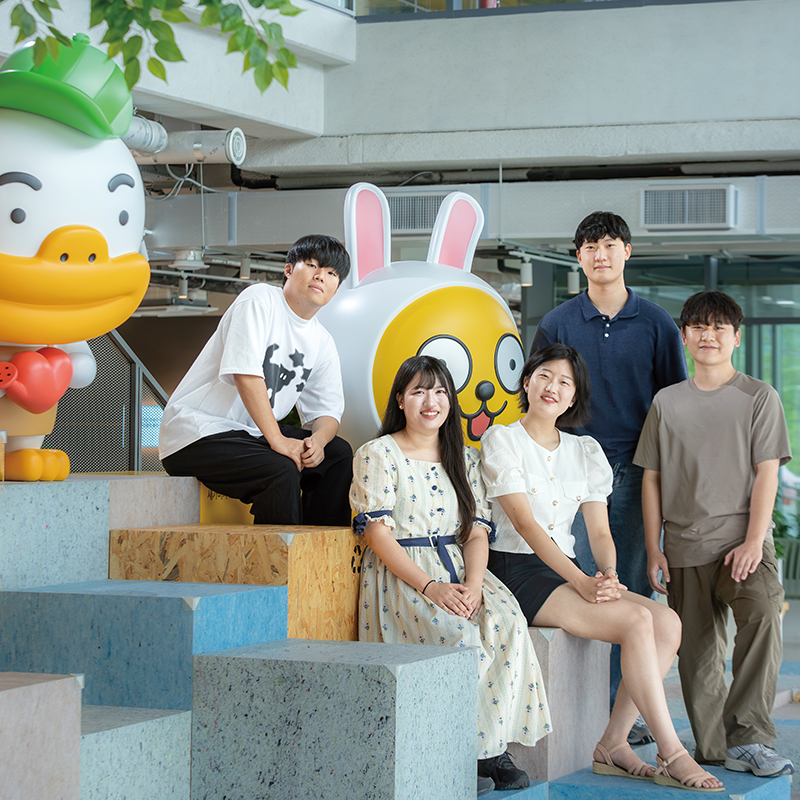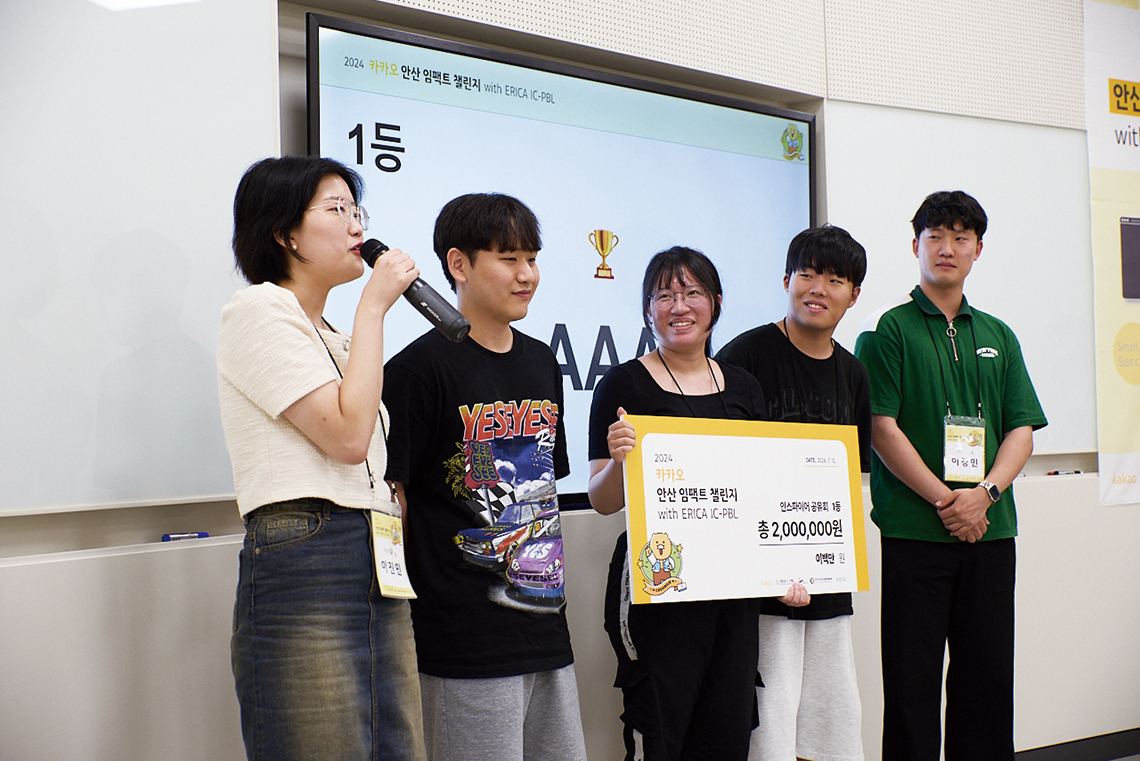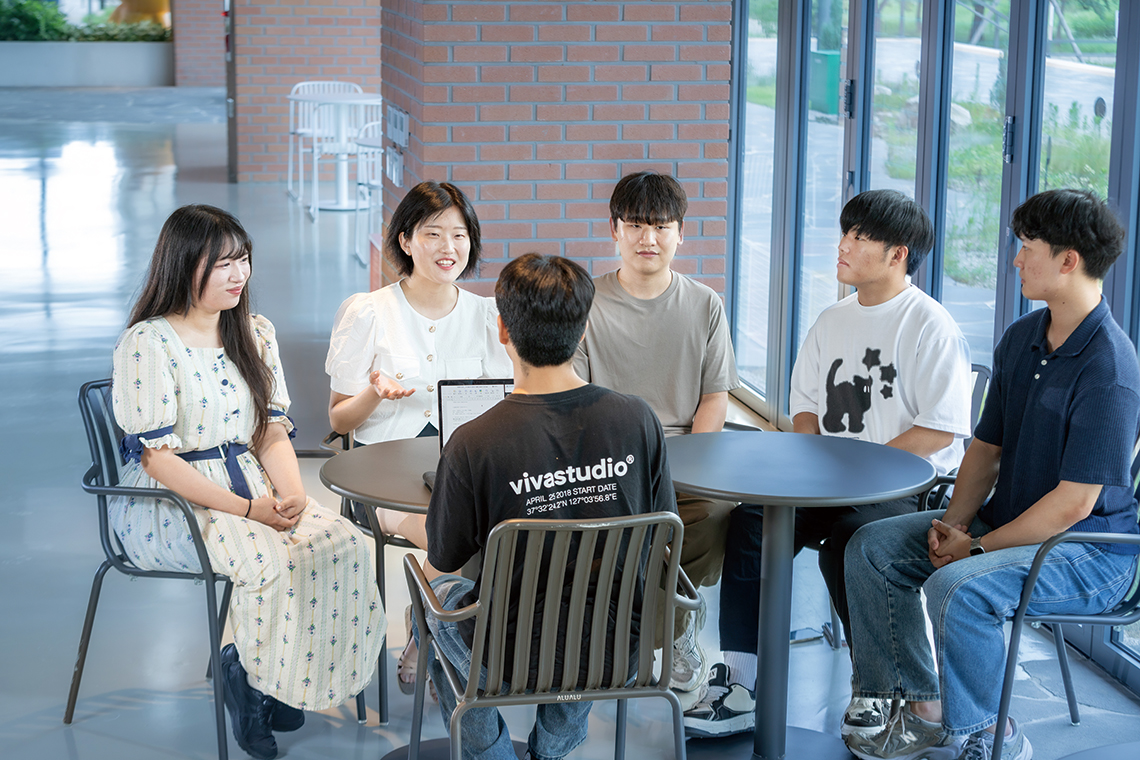Talent
Village Education for Migrant Youth in the Local Community
Come Visit the Forests of Ansan
Team “AAA,” First-Place Winner of the Kakao Ansan Impact Challenge
JinMin Lee (Department of Cultural Anthropology 2020), SangMin Park (Department of Chinese Studies, 2019), GangMin Lee (College of Computing, 2019), DongHee Lim (Division of Media, Culture and Design Technology, 2021), SeongHyeon Kim (Department of Advertising & Public Relations, 2023)
In July, during the summer vacation in a quieter campus than usual, the ”Kakao Ansan Impact Challenge with ERICA IC-PBL” program was held to address community issues and drive social innovation. Among the various local issues, Team AAA researched ”Support Measures for Youth with Migration Backgrounds” in response to the topic of ”Increasing Foreign Population.” As a result, they garnered attention with their innovative ideas for solving local problems in Ansan.
- Written by · Student Reporter SiEon Choi (Department of Media & Social Informatics, 2020)
- Organized by · the editorial office
- Photo by · HongBeom Ahan

Listening to Community Voices to Find Solutions
The “Kakao Ansan Impact Challenge” was held over two nights and three days. It is a program that utilizes designcentered thinking and IC-PBL education to identify and address local issues in Ansan and to find solutions through collaboration among ERICA, Kakao, and Ansan City. The core of the program is to derive actionable measures to address local problems based on community and user needs and to transform them into feasible policies and systems. Fifty ERICA students were organized into 10 teams of five members each to propose ideas based on selected topics. The proposals were then evaluated based on necessity, specificity, feasibility, and sustainability.
Team AAA won first place by presenting their idea titled ”Come Visit, the Forests of Ansan” which focused on ways for migrant youth to adapt to the community and become productive members of society. The team’s village education plan introduced the slogan ”It Takes a Village to Raise a Child” and received positive feedback from the evaluators.
The name ”AAA” contains multiple meanings: it stands for ”Ansan Associate Ansan” which aims to connect various stakeholders within Ansan to become a driving force for action much like the way AAA batteries are used to energize. The team members come from diverse fields including cultural anthropology, Chinese studies, and computer science. Their focus was on the keyword “increase of foreigners.” So why did they choose the topic of youth with migrant backgrounds? Team leader JinMin Lee answered this question as follows:
“As the proportion of foreign residents in Ansan has been increasing, various policies were developed but were mostly limited to adults. We started our project with the hope that children who migrated with their parents would be able to adapt well to Korea. We believe that addressing their learning gaps and cultural adaptation are crucial so we researched village education solutions.”
Student SangMin Park identified the lack of offline spaces for interaction between foreigners and local residents as a problem. Migrant youth face greater challenges in adapting to school due to language and cultural differences. This has led to a higher rate of absences and other social issues such as social deviance. The village education proposed by Team AAA aims to provide these youth with an emotionally supportive community in which connections with friends and adults can be achieved, before focusing on learning. It is more like a school that teaches practical culture and knowledge needed in real life rather than a traditional educational institution.
 Team AAA’s presentation during the Inspire Track at Kakao Ansan Impact Challenge
Team AAA’s presentation during the Inspire Track at Kakao Ansan Impact Challenge
Finding Solutions for Youth with Migrant Backgrounds
The Kakao Ansan Impact Challenge Program is divided into two main tracks: the Inspire Track and the Aspire Track. The former involves a two-night, threeday retreat to brainstorm and refine ideas. From the ten teams participating in this track, only three are selected to advance to the Aspire Track, where they work on actualizing their ideas.
In the Inspire Track, participants go through the Design Thinking Phase where they continuously propose and refine ideas. This is followed by the Persona Phase where they imagine the experiences of those affected by the problem. The next step involves identifying the individuals involved in the problem-solving process and finding solutions. Student DongHee Lim remarked, “I spent time while lying in bed before sleeping, reading papers and articles to identify stakeholders in the issue of foreign residents. I found a paper that addressed the problem of interrupted learning among youth with migrant backgrounds and chose that as our subject or “persona.”” Once the persona is defined, ideas are collected to develop measures. Team AAA showed exceptional focus and immersion in the project, with each member contributing diverse opinions which led to discovering interesting commonalities. Team leader JinMin Lee described the team’s unique dynamics with a smile, saying:
“There were difficulties in converging ideas into feasible solutions. Since each member had strong opinions, there were many disagreements. During the process of consolidating opinions, we often directly refuted what we thought were incorrect views. This might have seemed like arguments to others but it was actually the most effective and efficient way for us to proceed. I believe that open communication and discussions we engaged in led to our good results.”
Student SangMin Park emphasized that all the team members had the T (Thinking) personality on the Myers-Briggs Type Indicator (MBTI), otherwise known as a personality test.
“We focused on decision-making rather than sympathizing. We immersed ourselves in the problem and shared opinions without small talk. While this worked well within the team, it led to misunderstandings among people around us. We even had to make efforts to appear calm to clear up misunderstandings with our mentor.”
 Team AAA, which demonstrated strong unity with a clear direction, won first place in the Inspire Track.
Team AAA, which demonstrated strong unity with a clear direction, won first place in the Inspire Track.
Making the Village Education Ideas Sustainable
Starting in the latter half of this year, Team AAA will continue their work through the Aspire Track, taking IC-PBL classes at ERICA, and preparing systems and policies for actual village education in collaboration with Ansan City. Student KangMin Lee shared his thoughts on concretely and effectively realizing the team’s idea saying:
“I believe what we need for village education are the proper location and people. We are considering how to secure a venue at the Ansan Lifelong Education Center, which is preparing multicultural education. Also, having university students volunteer to teach children at the initial stage could be a useful approach.”
Team AAA plans to select local residents and university students to participate as teachers and to establish a location in collaboration with Ansan City that can function as a practical offline community space. Team leader JinMin Lee expressed his commitment to addressing any challenges saying, “It is people who face problems and also people who find solutions. Despite facing obstacles, I will work with my team to ensure that the village education for youth with migrant backgrounds program is established in Ansan.”
The team members, each specializing in different fields, shared their perspectives on addressing community issues. Hopefully, the insights they have shared will become operable measures that significantly contribute to the lives of the youth with migrant backgrounds.
* Youth with migrant backgrounds:
This refers to young people aged from 9 to 24 years, who have migrated, regardless of whether or not their parents migrated too.






